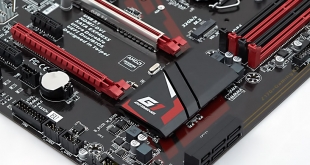
While the glitz and glamour of flagship motherboards may have many enthusiasts reaching for their wallets, most will spend a much more conservative sum on the board that forms the basis of their gaming system. The logic for that decision is sound – less money spent on a motherboard is more money to spend elsewhere on components that will enhance the gaming experience in more tangible ways, such as the graphics card.
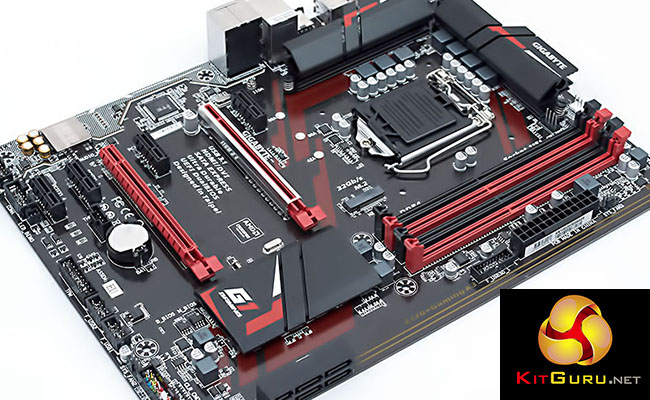
Gigabyte's Z170-Gaming K3 motherboard plays along nicely with that idea, costing just £95 which makes it the most affordable Gaming branded Z170 motherboard in the UK. Yet, you may still be pleasantly surprised by how much you get for your money with the Z170-Gaming K3 – few sacrifices have been made to reach such an aggressive price point.
Gigabyte has managed to include all the essentials for a Skylake gaming motherboard including good quality Realtek ALC1150-based audio, Killer E2200 networking, 32Gb/s M.2, 10Gb/s USB 3.1, SATA Express and a reasonably stylish red and black themed aesthetic.
Some of the areas where sacrifices appear to have been made include a lack of SLI support, a 7-phase VRM and a PCB which is more brown than black, but we'll analyse these things more closely as we progress through the review. At first glance the Gigabyte Z170-Gaming K3 looks to be a compelling option if you've got less than £100 to spend on a motherboard.
Features:
- Supports 6th Generation Intel® Core™ Processor
- Dual Channel DDR4, 4 DIMMs
- Fast USB 3.1 -The World’s Next Universal Connector
- 2-Way Graphics Support with Exclusive Ultra Durable Metal Shielding over the PCIe Slots
- Gen3 x4 M.2 Connector with up to 32Gb/s Data Transfer (PCIe NVMe & SATA SSD support)
- 2 SATA Express Connectors for up to 16Gb/s Data Transfer
- 115dB SNR HD Audio with Built-in Rear Audio Amplifier
- Killer™ E2200 Gaming Networks
- High Quality Audio Capacitors and Audio Noise Guard with LED Trace Path Lighting
- APP Center Including EasyTune™ and Cloud Station™ Utilities
- GIGABYTE UEFI DualBIOS™ Technology
The packaging design of the Gigabyte Z170-Gaming K3 motherboard highlights the fact the motherboard is part of the G1 Gaming series and that includes some premium content packs for World of Warships.
The back of the box is typical of motherboard marketing – an exhaustive list of features about what the Z170-Gaming K3 offers – USB 3.1, Killer Networking, high-definition audio, 32Gb/s M.2, LED lighting, and more….
The accessory bundle is par for the course – a couple of SATA cables, a padded & labelled rear I/O shield, various documentation, a case sticker and the World of Warships content codes. Gigabyte also includes a front panel “G Connector” that helps streamline the organisation of front panel cables to the motherboard header.
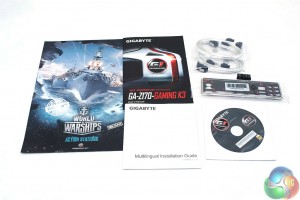 The Gigabyte Z170-Gaming K3 is a reasonably attractive board using a black & red themed design, though in certain lighting conditions the PCB does look more brown than black. However, this isn't anything unusual, the ASUS Z170-A (and numerous other boards) have similar PCBs. It's just something to keep in mind if you're going to be using LEDs inside your case – more light can make the brown colour more apparent.
The Gigabyte Z170-Gaming K3 is a reasonably attractive board using a black & red themed design, though in certain lighting conditions the PCB does look more brown than black. However, this isn't anything unusual, the ASUS Z170-A (and numerous other boards) have similar PCBs. It's just something to keep in mind if you're going to be using LEDs inside your case – more light can make the brown colour more apparent.
Looking underneath we find the usual characteristics of an entry-level motherboard – a pushpin system to hold the CPU heatsinks in place with normal Philips-head screws for the chipset heatsink. The heatsinks around the CPU are a little on the wobbly side, but certainly not in danger of falling off. Along the edge of the Z170-Gaming K3 you'll find some red LED strips with 33 LEDs in total, adding in the 14 around the audio PCB makes a grand total of 47 individual LEDs underneath the Gaming K3.
The Z170-Gaming K3 supports a standard arrangement of up to 64GB of DDR4 memory, Gigabyte are verifying speeds of up to 3466MHz, but you may be able to push further depending on the quality of the CPU and DRAM being used. Near the memory lanes you'll find the three fan headers (2 CPU, 1 Chassis), a USB 3.0 header and the 24pin power connection which are slightly offset away from the edge of the motherboard.
This offsetting appears to be so that there is room for the bottom-mounted LEDs to shine through the corresponding translucent strips. There are no debug code readers or LEDs to be found which is unfortunate but not unexpected for the price point.
For storage options Gigabyte offer the standard 6 SATA III ports, of which four are shared with two SATA Express ports. Two SATA Express ports in itself is more than we'd expect for this type of board, though uses of SATA Express are still limited. Four of the SATA ports are horizontal while two are vertical – this may prove problematic in terms of cable management and overall aesthetics.
With respect to PCI Express connectivity the options for the full sized PCIe lanes are 16X and 4X – meaning support for AMD's CrossFire but not Nvidia's SLI. This is a physical limitation as the slot is only wired for 4X, so it's not a case of licensing – e.g. where the board supports SLI but Gigabyte haven't licensed it. The primary 16X slot has PCIe slot reinforcement which should prevent warping and deformation over time from heavy graphics cards, it also adds a nice aesthetic to the board.
Audio is isolated on a separated and red LED-lit PCB segment, it houses the Realtek ALC1150 codec which is shielded fully, there are 7 Chemicon audio capacitors around it that handle power duties. We've also spotted a Texas Instruments OPA1652 operational amplifier which should help drive any gaming headsets chosen by the user. We find it strange that Gigabyte doesn't mention this on the website or in the product marketing as it's definitely a value-added inclusion.
The rear I/O is reasonably well equipped – 4 USB 3.0, 2 USB 3.1, two display outputs, Gigabit LAN, 6 analogue audio jacks and a PS/2 combo port. It's a little disappointing that there's no type-C port available and six USB ports in total is a little slim. However, considering the price point and the target audience, the rear I/O is fit for purpose.
The CPU VRM implementation is 7 phases which should still be enough for pushing any Skylake chip to its maximum. At this price bracket the number of VRMs varies anywhere between 6 and 10 phases, so Gigabyte is more towards the lower-end of that range.
Along the lower-end of the motherboard is the rest of the connectivity options which includes two USB 2.0 headers (4 USB 2.0 ports total), a TPM header, colour-coordinated front panel connectors, a COM port and the front panel HD Audio connector which sits on the isolated audio section PCB. If inspecting closely you'll also see the “B_BIOS” and “M_BIOS” chips which are the backup and main BIOS chips that comprise the Gigabyte DualBIOS design.
Two ports stand out as being a little strange: the Thunderbolt add-in card connector, a feature unlikely to be used by the target audience of this product, and the “LED_DEMO” port which is a 2 pin connection. Gigabyte doesn't specify the use of this port in the manual or on the website, it's treated as if it isn't even there.
Gigabyte's UEFI design appears to have changed somewhat since previous generation (Z97) motherboards where the company maintained two independent BIOS areas – one high-resolution “new” style UEFI and another more traditional UEFI design. That traditional UEFI design seems to be the one Gigabyte chose to keep, at the expensive of the prettier UEFI. We certainly have no complaints as the traditional UEFI does the job very well and feels more intuitive based on what we'd expect from a motherboard UEFI.
Gigabyte keep the main overclocking and tweaking settings within the M.I.T (Motherboard Intelligent Tweaker) section. All settings related to frequencies (advanced frequency settings), memory (advanced memory settings), voltages (advanced voltage settings) and fan controls or temperatures (PC health status) can be found in here.
The advanced frequency settings section will allow you to change the CPU clock ratio, base clock and tune things like Speed Step and Turbo behaviour. In the advanced memory settings area you'll find timing adjustments, XMP options, interleaving and other settings to aid memory compatibility.
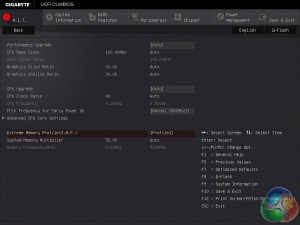
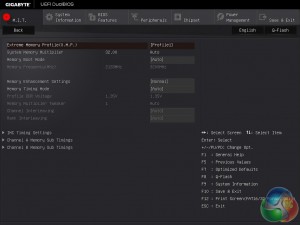
The advance voltage settings area will give you the option to set System Agent, VCCIO, PLL, CPU graphics and VCore voltages, most inexperienced users will be better served by leaving these on Auto. You'll also be able to find voltage options for the chipset & DRAM as well as options to manipulate the Load Line Calibration (LLC).
The remaining tabs provide an assortment of miscellaneous settings covering things like POST behaviour, configuration of onboard controllers (SATA/USB/Audio/Networking), power options and more.
Most motherboard vendors have a central piece of software that coordinates all the various different utilities on offer. Gigabyte's particular version of this is “APP CENTER”, a delightfully simple dashboard which arranges the icons of all the Gigabyte utilities installed. You simply click each icon to launch each utility, most of which are independent executable files so you can run as many, or as few, as you want at any given time.
The performance-related utility is EasyTune which offers a number of preset auto-overclocking profiles for unlocked Skylake processors as well as in-OS voltage and frequency tuning options.
System Information Viewer is another useful tab since it allows you to tune all the connected fans using either preset profiles or custom fan curves. The software will calculate the full RPM range of your fan first to help you get the most out of each fan.
While there are many more utilities the last one that we found interesting is “Ambient LED”. This motherboard doesn't have RGB, so most of the utility can't be used, but it's still great to see you can choose between static, pulsing or “beat” LED modes, failing that you can turn the LEDs off altogether.
Intel’s Skylake processors are just the latest Intel CPU architecture to see many of the critical system operations handled by the processor. As such, benchmarking a motherboard becomes more of a test to certify that the part operates correctly and meets the anticipated performance levels.
Z170 Motherboard Test System:
- Processor: Intel Core i7-6700K (4.2GHz all-core turbo).
- Memory: 16GB (4x4GB) G.Skill Ripjaws V 3200MHz 16-16-16-36 DDR4 @ 1.35V.
- Graphics Card: Nvidia GTX 980 Ti.
- System Drive: Mushkin Chronos 120GB
- Storage Test Drive: OCZ Trion 150 480GB (with a USB 3.0 to SATA adapter for USB 3.0 testing.)
- CPU Cooler: Antec Kuhler H20 1200
- Power Supply: Seasonic Platinum 760W.
- Operating System: Windows 10 Pro 64-bit.
Comparison Z170 Motherboards:
Software:
- Gigabyte BIOS F2 (Release Date 10/03/2016)
- Nvidia GeForce 364.72 WHQL Driver
Tests:
- Cinebench R15 – all core CPU test and CPU power consumption figures.
- Handbrake – converting a short 720p movie file into a smartphone suitable format using the Android preset.
- SiSoft Sandra – processor arithmetic and memory bandwidth test sequences.
- AIDA 64 Engineer – memory and cache test.
- 3DMark – Firestrike (1080p) test.
- Ashes of the Singularity – built-in benchmark tool @ 1080p using the Crazy preset.
- Unigine Valley – built-in benchmark using the Extreme HD preset.
- Rightmark Audio Analyser – record and playback test using a line-in to line-out loopback on a high quality gold-plated 3.5mm cable.
- ATTO – default disk benchmark for SATA and USB testing
Cinebench R15
Cinebench is an application which renders a photorealistic 3D scene to benchmark a computer's rendering performance, on one CPU core, all CPU cores or using the GPU. We run the test using the all core CPU mode.
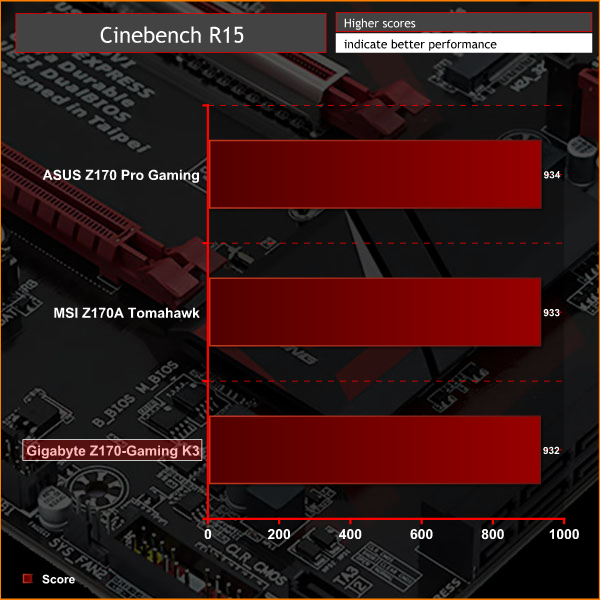
Handbrake
Handbrake is a free and open-source video transcoding tool that can be used to convert video files between different codecs, formats and resolutions. We use Handbrake to convert a short 720p into the Android preset built into the application.
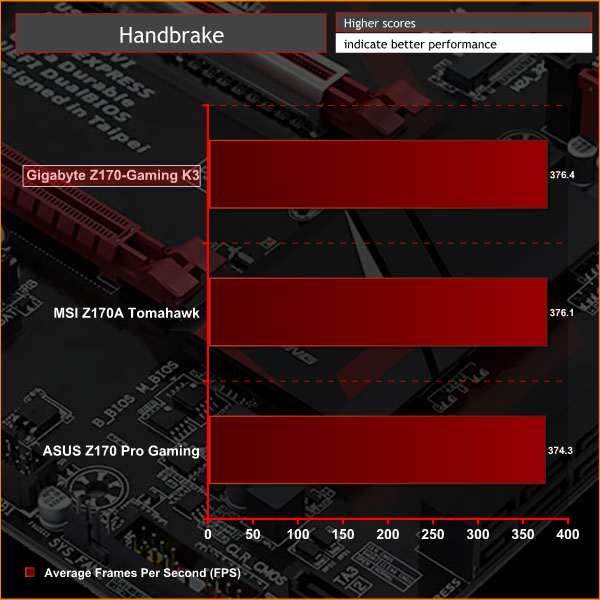
SiSoft Sandra
SiSoft Sandra 2016 is a multi-function utility program that supports remote analysis, benchmarking and diagnostic features for PCs, servers, mobile devices and networks. We run the application's processor arithmetic test to gauge the CPU performance on each tested motherboard.
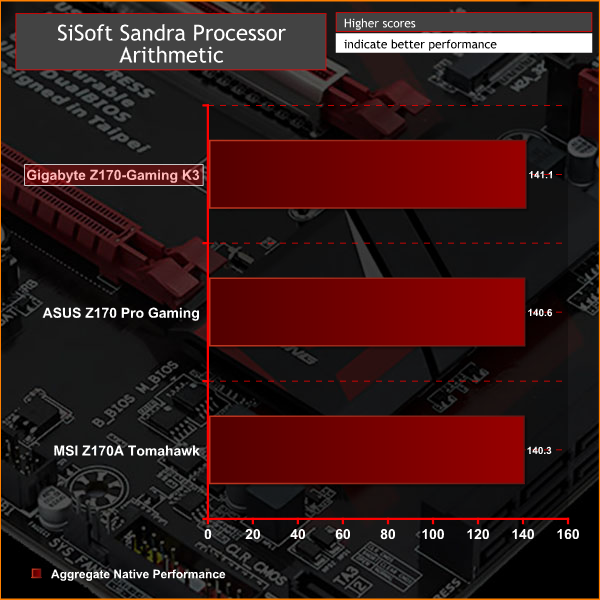
CPU performance is within margin of error for all tested Z170 motherboards once you standardise for different Turbo mode behaviour tweaks the vendors use. Most will automatically enable various turbo enhancements that increase the average operating frequency of Intel's CPUs, this is often implemented with XMP profiles. This can give the impression some motherboards are “faster” than others when in reality they just overclock the CPU more. In our testing we found that Gigabyte doesn't automatically implement all-core turbo when enabling the XMP profile, but we standardised for this by adjusting the multiplier hence all the results appear equal.
AIDA64 Engineer
AIDA64 Engineer is a multi-featured software suite for diagnostics, stress testing, benchmarking, software auditing and various other measurement parameters. We use AIDA64 Engineer to benchmark memory throughput and latency.
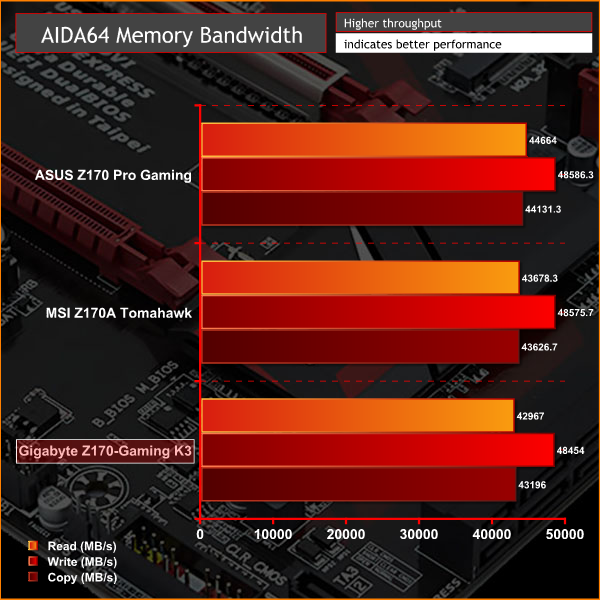
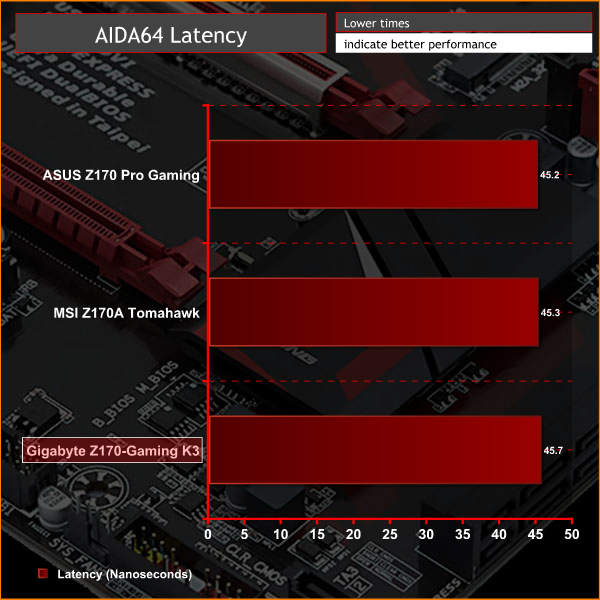
SiSoft Sandra
SiSoft Sandra 2016 is a multi-function utility program that supports remote analysis, benchmarking and diagnostic features for PCs, servers, mobile devices and networks. We use the SiSoft Sandra memory bandwidth test to give us an extra set of memory bandwidth results.
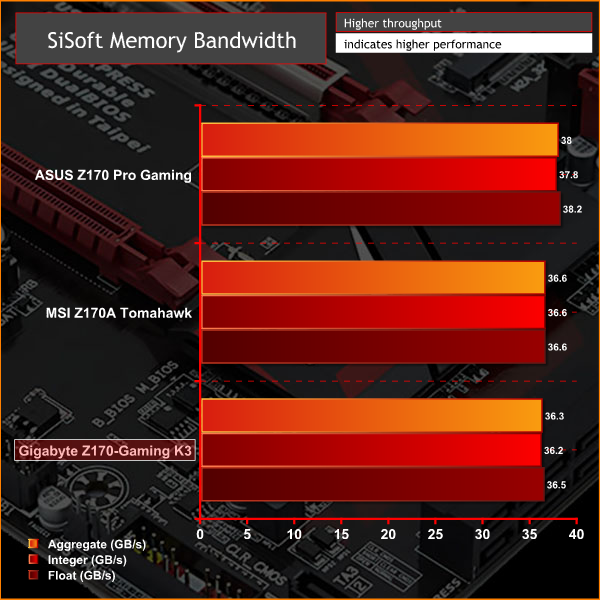
Synthetic memory performance sees Gigabyte's Z170-Gaming K3 tie with MSI's Z170A Tomahawk, the ASUS Z170 Pro Gaming comes out a few percentage points in the lead. In real-world applications though, this small deficit for Gigabyte and MSI versus ASUS doesn't materialise into anything.
3DMark
3DMark is a multi-platform hardware benchmark designed to test varying resolutions and detail levels of 3D gaming performance. We run the Windows platform test and in particular the Firestrike benchmark, which is indicative of high-end 1080p PC Gaming.
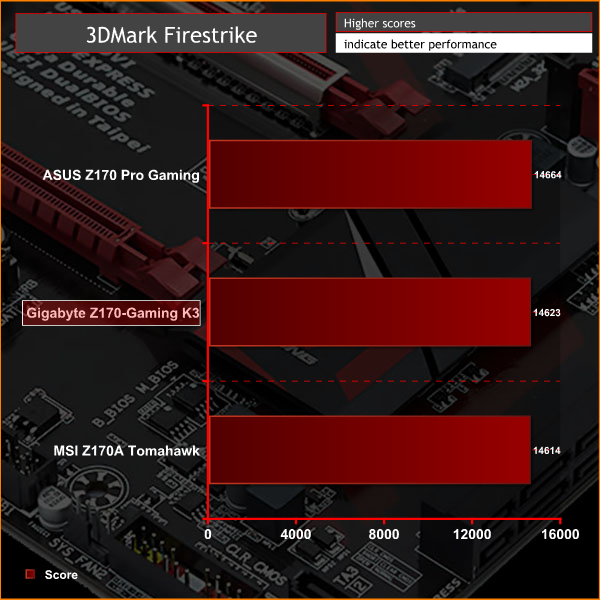
Ashes of the Singularity
Ashes of the Singularity is a Sci-Fi real-time strategy game built for the PC platform. The game includes a built-in benchmark tool and was one of the first available DirectX 12 benchmarks. We run our tests using DirectX 11, a 1080p resolution and the Crazy preset.
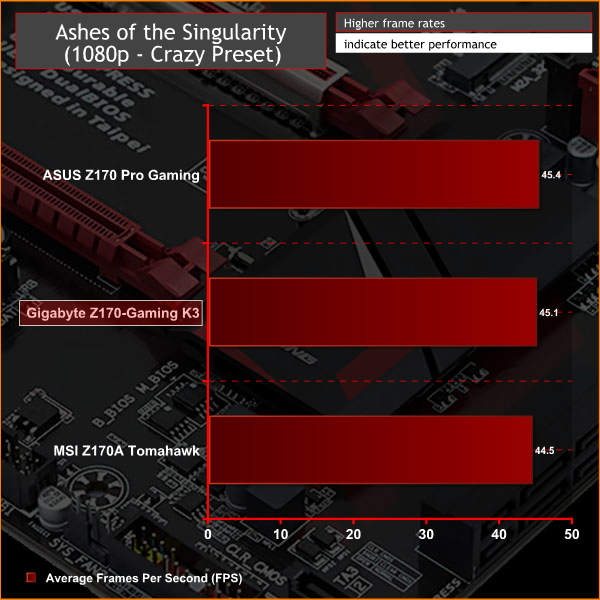
Unigine Valley
Unigine Valley is a GPU stress testing and benchmarking tool that succeeds its predecessor, Unigine Heaven. Valley makes use of dynamic lighting, depth of field, ambient occlusion and dynamic weather patterns. We utililise the built-in benchmarking tool with the Extreme HD preset.
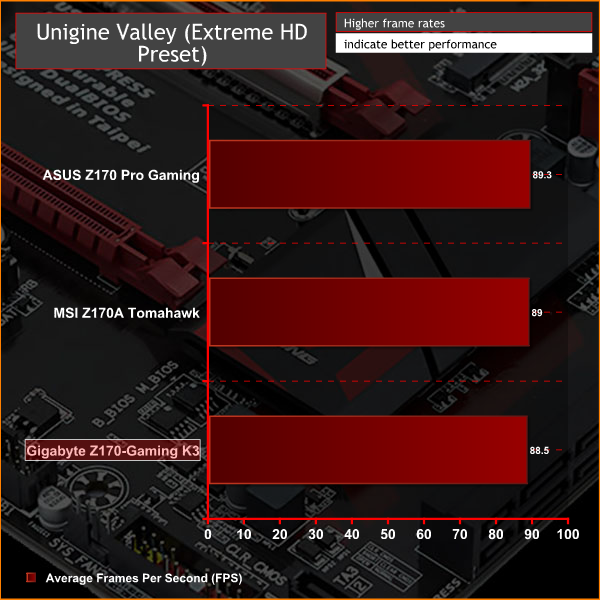
Like with our CPU tests there's no variation to speak of between Gigabyte's Z170-Gaming K3 and other Z170 boards in GPU-centric benchmarks.
ATTO Disk Benchmark
The ATTO disk benchmark is a Windows-based utility for testing storage performance of any storage drive or controller. We use the default benchmark setup and run this on an OCZ Trion 150 SSD directly connected to the SATA ports and then again over a USB 3.0 port using a USB 3.0 to SATA III adapter.
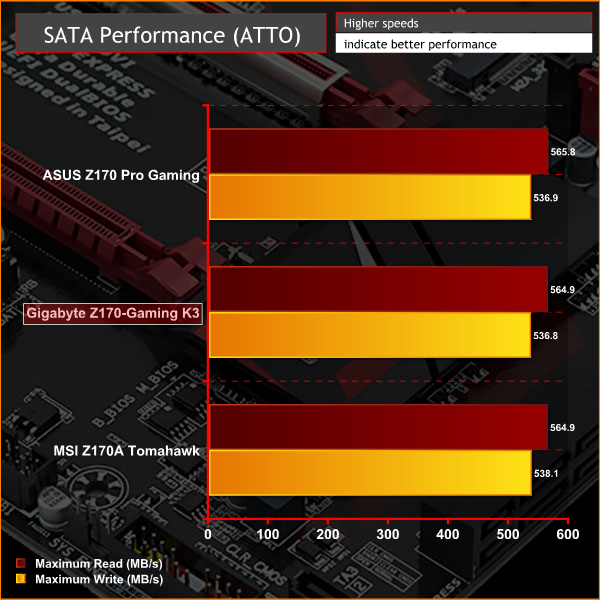
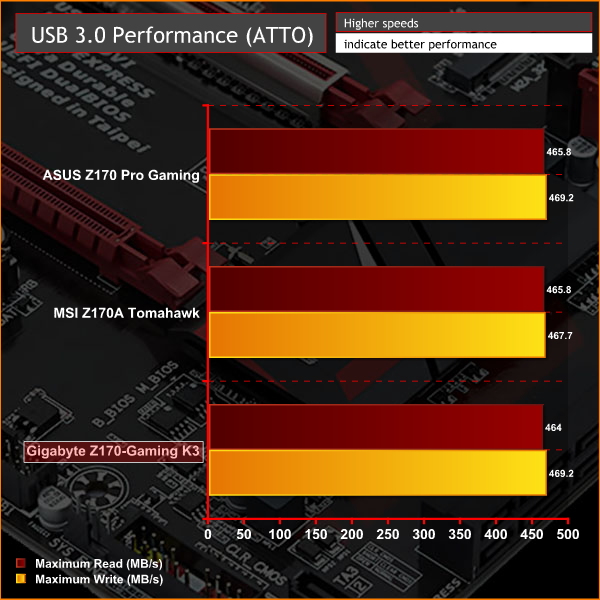
As we'd hope to see Gigabyte's SATA and USB ports performance at full capacity once all the appropriate motherboard drivers are installed. There was no need to enable UASP or BOT modes to achieve these USB 3.0 speeds on our Windows 10 test system, though in Windows 7 and 8.X this may be required.
Rightmark Audio Analyser
Rightmark Audio Analyser is a freeware benchmarking utility designed to objectively test the performance characteristics of audio solutions. We setup a line-in line-out loop and execute the record/playback test before generating the results report you see below. This test was run at 24bit audio depth and 192KHz frequency.
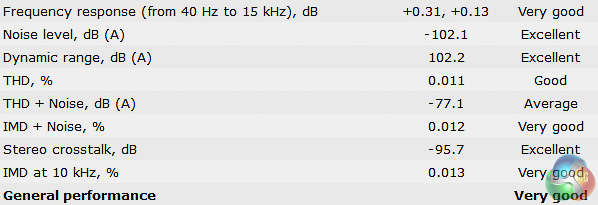
The results from Gigabyte's Z170-Gaming K3 aren't quite as good as what we observed with the more expensive ASUS Z170 Pro Gaming, nonetheless the overall result of “Very Good” is excellent for the price point. The only notable blemish was an “Average” score for Total Harmonic Distortion and Noise.
Power Consumption
We leave the system to idle on the Windows 10 desktop for 5 minutes before taking a reading, for CPU load results we run Cinebench and take a reading in the middle of the render progress.
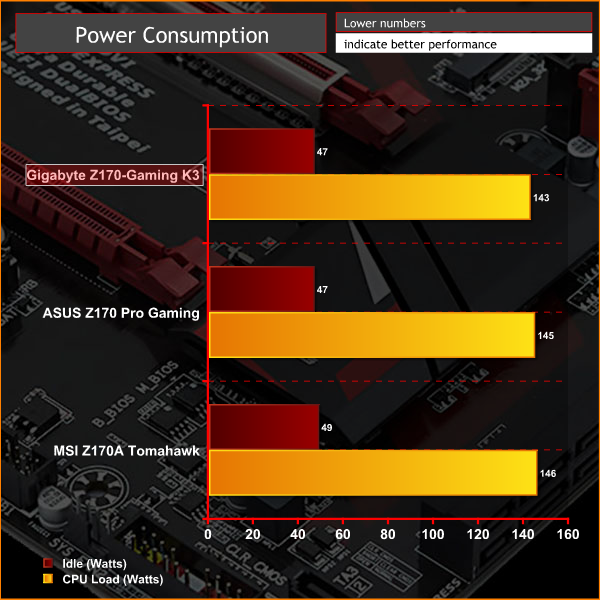
Power consumption for Gigabyte's entry-level Gaming motherboard reflected that of its rivals – these are fairly “barebone” motherboards with few, if any, extras features or controllers that can drive power consumption up substantially.
Overclocking
We use a manually set voltage of 1.4 volts on the CPU VCore and see how far we can push the CPU by adjusting the multiplier 1X at a time. In general we found that our maximum overclock of 4.7GHz was consistent across a number of motherboards suggesting it to be a CPU limitation that relates to the quality of the silicon.
Gigabyte's Z170-Gaming K3 achieved 4.7GHz without any issues and under loading voltage control was adequate, falling no lower than 1.38 volts when we had set 1.4. A “droop” of 0.02 volts is slightly worse than voltage control we witnessed on ASUS and MSI's equivalents but it didn't have any impacts on system performance or stability. Furthermore, a more aggressive load line calibration profile did “correct” the voltage drop-off.
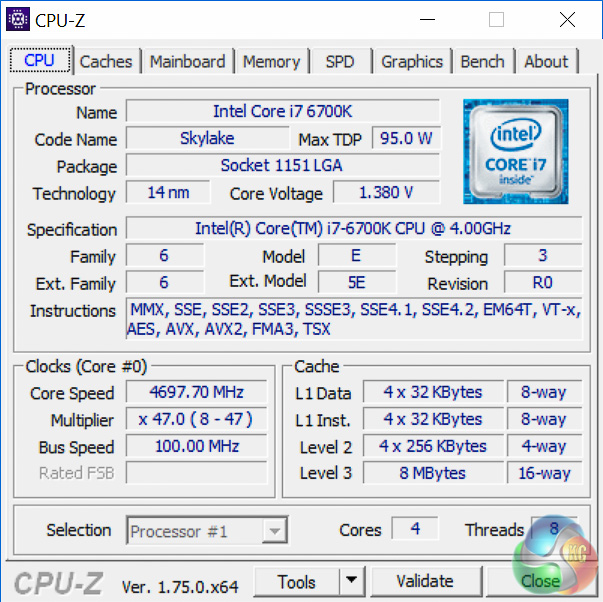
Performance scaled as expected with the frequency increase we achieved.
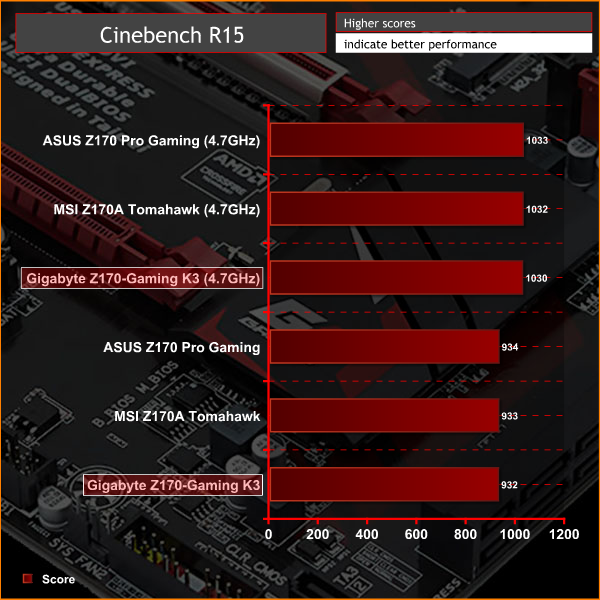
Power consumption was a little higher on the Gigabyte Z170-Gaming K3 at stock than rival boards, due to the way it handles speed-stepping and idle voltage controls. There is perhaps a way to correct this in the UEFI so the board properly steps down and down-volts at idle, but we were unable to find the appropriate setting to enact this. Load power consumption was also a little higher but this was most probably from the more aggressive default CPU fan profile that caused the fans to spin faster, thus consuming more power.
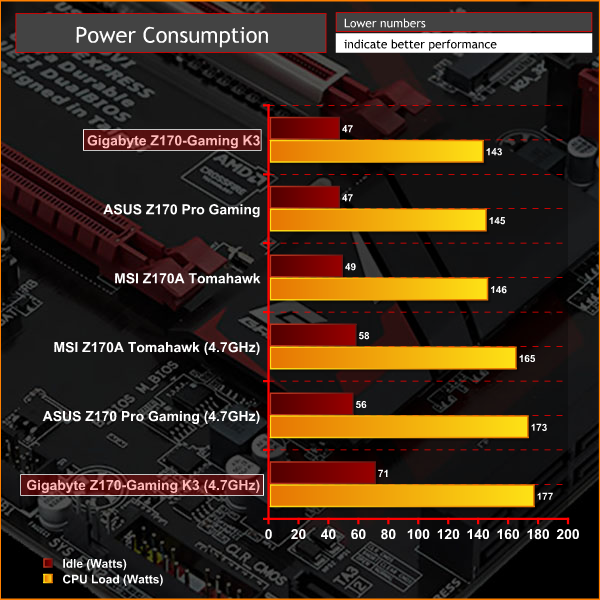
Gigabyte's Z170-Gaming K3 motherboard has done a lot to impress us when you keep the price point of £95 in mind. For the feature set on offer, the selection of connectivity and the quality of audio and networking hardware, it's a commendable achievement that Gigabyte is even able to offer this motherboard at its current price. It certainly lacks some of the pizzazz and wow-factor of Gigabyte's higher-end offerings, like the Z170X-Gaming 7, but it still carries all the fundamentals required for an excellent Skylake gaming experience and makes up for any shortfalls with its competitive price point.
The Gaming K3 does have some shortfalls that prospective buyers will need to consider, it's not a perfectly executed motherboard. We found the number of USB ports to be a little wanting, 6 USB 3.0, 2 USB 3.1 and 4 USB 2.0, that's 2 to 4 less than some other entry-level gaming motherboards – an extra pair of USB 2.0 ports in the rear I/O area would have been great to see. There's also no USB Type-C, again this isn't a deal breaker, but something worth keeping in mind.
Moving onto the aesthetics and we have found the dark brown PCB to be a bit of a let-down, sure the board makes up for this in many other areas but many people “buy with their eyes”. We feel that a black PCB would be worth the additional investment, glossy or matte. There are also some other minor layout niggles, such as the fact some of the SATA ports are vertical and others are right-angled, or that the 24 pin and USB 3.0 header are offset from the edge of the motherboard PCB to make room for the LED strip.
The lack of SLI capabilities is another notable omission but we'll reiterate again that for the price point it's a sensible decision and most budget PC builders are unlikely to ever utilise an SLI setup.
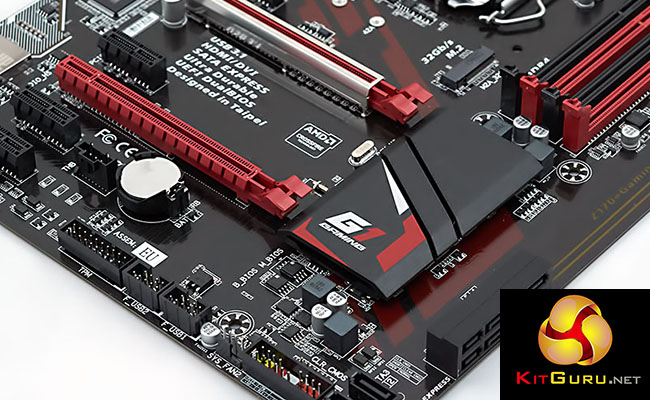
The Gigabyte Z170-Gaming K3 covered all other bases well – it overclocked strongly despite the middling 7-phase VRM, performed well across all our benchmarks and offers all the key connectivity standards like USB 3.1, 32Gb/s M.2, DDR4 SATA Express and quality Gigabit LAN. Gigabyte's UEFI is cleanly designed and intuitive to use, we also appreciate the fact Gigabyte include two BIOS chips for redundancy to insure against a BIOS chip failure. Gigabytes software is a little more unified, through App Center, and simpler to use than some rival software options.
Assessing the overall package on offer it seems that the Z170-Gaming K3 best targets DIY system builders and PC Gamers who have a reasonably tight budget, but still want to take advantage of Intel's latest Skylake platform. You'll be hard-pressed to find an equivalently spec'd motherboard for the same price, though there are better motherboards available at higher price points. Relating back to the original starting point of this review, the Z170-Gaming K3 is a great board for maximising the budget available for a better graphics card or gaming peripherals, without sacrificing on key features or system performance.

Buy from Overclockers UK for £95.99 inc vat HERE.
Discuss on our Facebook page over HERE.
Pros:
- Highly competitive price
- Unified software package and intuitive UEFI
- Strong performance and overclocking
- Includes all Skylake's new connectivity standards (USB 3.1, M.2 NVMe, DDR4)
- Bright and controllable red LED lighting
Cons:
- No SLI support or USB Type-C
- Some design quirks (dark brown PCB, loosely secured CPU heatsinks, questionable port placements)
KitGuru says: Gigabyte's Z170 Gaming-K3 is another strong contender in the affordable motherboard space. If you have about £100 to budget for a gaming motherboard, this is arguably one of the best options available.
 KitGuru KitGuru.net – Tech News | Hardware News | Hardware Reviews | IOS | Mobile | Gaming | Graphics Cards
KitGuru KitGuru.net – Tech News | Hardware News | Hardware Reviews | IOS | Mobile | Gaming | Graphics Cards


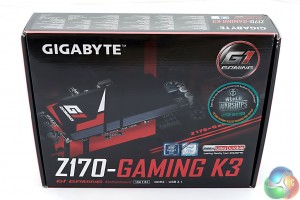




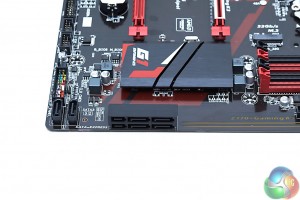
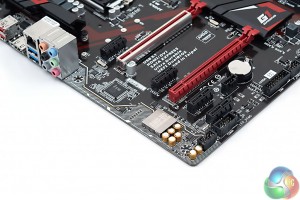
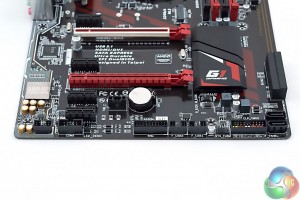
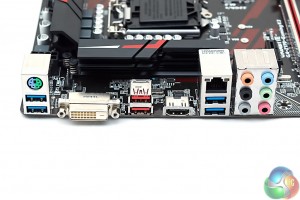
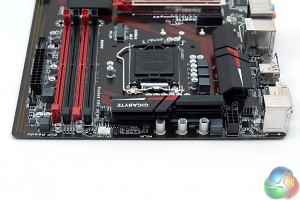
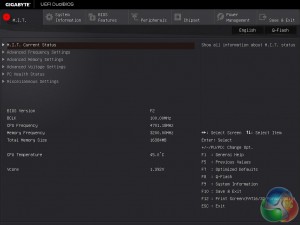
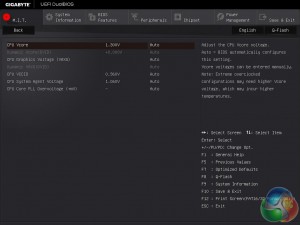
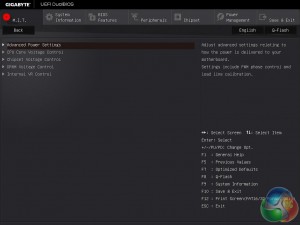
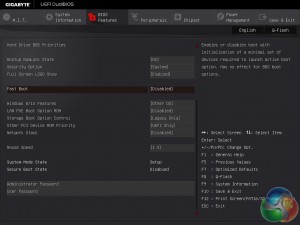
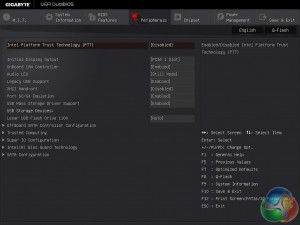
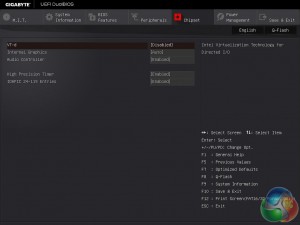
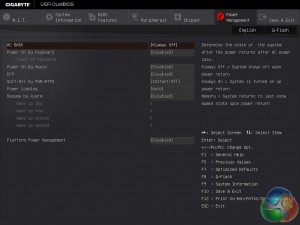

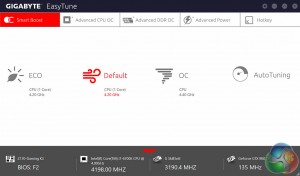
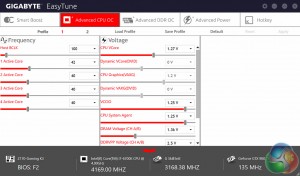
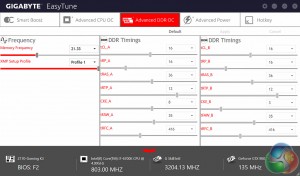
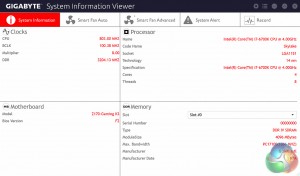
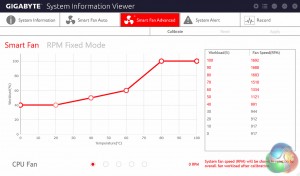
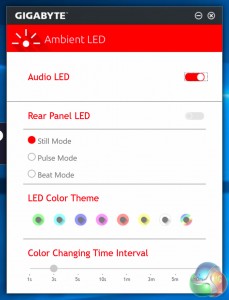
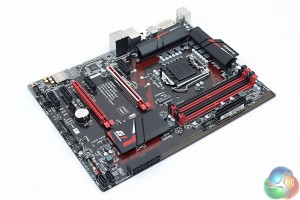


Your problem with the CPU not down-clocking when idle is probably due to one of the following reasons…
1/ You’re running Windows with the performance profile enabled rather than using balanced,
2/ You’re forcing a CPU core voltage which is a totally nonsensical way to overclock a Skylake CPU.
Try running the balanced Windows profile and applying a positive CPU core voltage offset instead. It will work flawlessly and exactly as intended on this motherboard.
This does work well with 7th generation intel right?
Gigabyte motherboards for gaming desktops, Laptop with gaming motherboard, motherboard price in Delhi, online gigabyte motherboard, all types of gaming motherboards are available at Modi Infosol Pvt. Ltd
zte routers
Ideas are great about the product, the big things is that it having long lasting and also available at affordable price.
online power banks for mobile